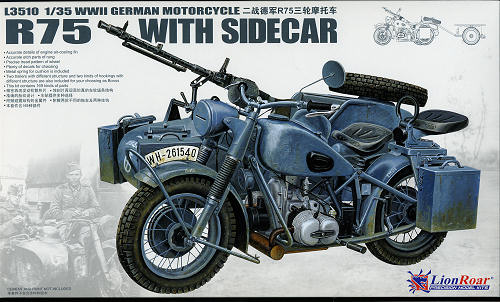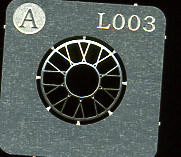
Lion Roar 1/35 BMW R75 with Sidecar
| KIT #: | L3510 |
| PRICE: | $45.50 HSSRP |
| DECALS: | Multiple options |
| REVIEWER: | Scott Van Aken |
| NOTES: | Highly detailed multimedia kit with wire wheels |

| HISTORY |
The BMW R75 was World War II-era motorcycle and sidecar combination produced by the German company BMW.
BMW were already producing a number of popular and highly effective motorcycles, and developed the R75 in response to a request from the German army to make a machine more capable in off-road conditions, the Zündapp KS 750. BMW copied the technically advanced Zündapp KS 750 in which the third side-car wheel was driven from an axle connected to the rear wheel of the motorcycle, effectively making it a three-wheeled vehicle. Fitted with a locking differential and selectable road and off-road gear ratios the R75 was highly manoeuvrable and capable of negotiating most surfaces. It was even fitted with a reverse gear.
The BMW R75 and its rival the Zündapp KS 750 were both widely used by the Wehrmacht in Russia and North Africa, though after a period of evaluation it became clear that the Zündapp was the superior machine. In August 1942 Zündapp and BMW, on the urging of the Army, agreed upon standardization of parts for both machines, with a view of eventually creating a Zündapp-BMW hybrid, in which a 286/1 side-car would be grafted onto a Zündapp KS 750 motorcycle. They also agreed that the manufacture of the R75 would cease once production reached 20,200 units, and after that point BMW and Zündapp would only produce the Zündapp-BMW machine, manufacturing 20,000 each year.
Since the target of 20,200 BMW R75's was not reached, it remained in production until the Eisenach factory was so badly damaged by Allied bombing that production ceased in 1944. A further 98 units were assembled by the Soviets in 1946 as reparations.
However the standardisation programme meant that machines that were produced by BMW and Zündapp used 70% of the same components. This simplifies the supply of spare parts for these vehicles, many of which are still in the hands of historic motorcycle enthusiasts. These vehicles are still highly desirable as collector's items because of their complex and durable technology, and are correspondingly expensive. A well-restored R75 can be still used for everyday purposes, on or off-road without problems.
In 1954 a small number of modified R75's was produced at Eisenach (then in Soviet-controlled East Germany) for testing under the designation AWO 700, but were not put into full production.
| THE KIT |
 Hot on the heels of their superb Zundap kit is this one on the BMW R75 with sidecar and a pair of trailers. Like the Zundap, this is by far one of the most detailed 1/35 motorcycle kits that I have seen. There are no lack of parts in this one so it would be best to have had a few parts intensive kits under your belt. 169 parts in a 1/35 motorcycle set is nothing to sneeze at.
Hot on the heels of their superb Zundap kit is this one on the BMW R75 with sidecar and a pair of trailers. Like the Zundap, this is by far one of the most detailed 1/35 motorcycle kits that I have seen. There are no lack of parts in this one so it would be best to have had a few parts intensive kits under your belt. 169 parts in a 1/35 motorcycle set is nothing to sneeze at.
The importer states:
- Accurate engine air-cooling fin details.
- Accurate photo-etched parts.
- Precise tire tread pattern with marks.
- Good selection of decals.
- Seat cushion metal spring is included.
However, this is only the tip of things. There are photo etch wire wheels, a completely de tailed engine and sidecar, and there is a trailer that was often used by these vehicles included in with the kit. Actually, there are two trailers. One with wood spoke wheels and the other with steel wheels.
tailed engine and sidecar, and there is a trailer that was often used by these vehicles included in with the kit. Actually, there are two trailers. One with wood spoke wheels and the other with steel wheels.
Molding is superb and Lion Roar has gone the extra step to ensure that all of the fragile parts are well protected. The molded etched wire wheels are provided with additional wrapping and most sprues are packaged one to a polybag. Another small photo etch fret includes some smaller bits like the driver's foot rests and some linkages, for example.
While markings are shown for a desert painted version with the Ramcke Brigade in Libya during 1942, and a grey 11th Panzer division bike, there are other markings on the decal sheet. The instructions are quite well drawn, have Gunze paint references and have a number of detail drawings to help you with the assembly.
| CONCLUSIONS |
Though not a kit for the meek, those willing to tackle it will be assured of a superb representation of one of the more popular bikes of WWII and one that spawned decades of eagerly sought street bikes as well.
| REFERENCES |
February 2009
Thanks to www.dragonmodelsusa.com for the preview kit. Get yours today at your local shop or on-line retailer.
If you would like your product reviewed fairly and fairly quickly, please contact the editor or see other details in the Note to Contributors.